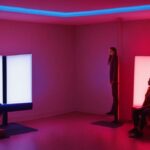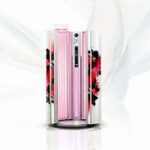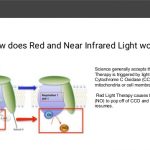Light therapy, also known as phototherapy, is a treatment that uses a particular wavelength of light to address a variety of health conditions like depression, skin disorders, and sleep disorders, among others. In recent years, there has been growing interest in the effectiveness of light therapy, particularly for treating seasonal affective disorder (SAD), a type of depression that typically occurs in the autumn and winter months. In this article, we will explore the question – does light therapy help alleviate the symptoms of SAD?
Contents
Understanding Light Therapy
Light therapy is a non-invasive treatment that uses specific wavelengths of light to improve mood, sleep, and skin health. This type of therapy has been used for centuries and has been shown to have a significant impact on a person’s mental and physical well-being. Light therapy is commonly used to treat conditions such as seasonal affective disorder (SAD), insomnia, and acne.
How Does Light Therapy Work?
Light therapy works by exposing the body to specific wavelengths of light, typically between 400 and 700 nanometers. This range of light is known as visible light and is responsible for the colors that we see. When the body is exposed to these wavelengths of light, it triggers a response in the brain that can improve mood, regulate sleep cycles, and reduce inflammation.
Types of Light Therapy
There are several types of light therapy, including bright light therapy, blue light therapy, and red light therapy. Bright light therapy involves exposure to a lightbox that emits a bright light, usually around 10,000 lux. Blue light therapy is commonly used to treat acne and involves exposure to blue light, which has been shown to kill the bacteria that causes acne. Red light therapy is used to treat skin conditions such as wrinkles and scars and involves exposure to red light, which has been shown to increase collagen production in the skin.
The Benefits of Light Therapy
Light therapy is a non-invasive treatment that uses specific wavelengths of light to improve mood, sleep, and skin health. It works by exposing the body to specific wavelengths of light, typically between 400 and 700 nanometers, triggering a response in the brain that can improve mood, regulate sleep cycles, and reduce inflammation. There are several types of light therapy, including bright light therapy, blue light therapy, and red light therapy. Light therapy has been shown to have significant benefits for mood regulation, sleep regulation, and skin health. However, there are some potential risks to be aware of, such as mild side effects and, in rare cases, mania in people with bipolar disorder. It is important to speak with a healthcare professional before starting light therapy to determine if it is the right treatment option for you.
Mood Regulation
Light therapy has been shown to have a significant impact on a person’s mood, particularly in those who suffer from seasonal affective disorder (SAD). This type of depression is caused by a lack of sunlight during the winter months and can lead to feelings of sadness, fatigue, and irritability. Light therapy has been shown to regulate the body’s circadian rhythms, which can improve mood and reduce symptoms of SAD.
Sleep Regulation
Light therapy has also been shown to regulate sleep cycles and improve sleep quality. Exposure to bright light in the morning can help regulate the body’s natural sleep-wake cycle, which can improve sleep quality at night. Light therapy has also been shown to reduce symptoms of insomnia by improving sleep efficiency and reducing the amount of time it takes to fall asleep.
Skin Health
In addition to its mental health benefits, light therapy has also been shown to have a significant impact on skin health. Red light therapy has been shown to increase collagen production in the skin, which can reduce the appearance of wrinkles and scars. Blue light therapy has been shown to kill the bacteria that causes acne, making it an effective treatment for this condition.
Potential Risks of Light Therapy
While light therapy is generally considered safe, there are some potential risks to be aware of. Some people may experience mild side effects such as headaches, eye strain, or nausea. In rare cases, light therapy can trigger mania in people with bipolar disorder.
Benefits of Light Therapy
Mood Regulation
Light therapy has been shown to have a significant impact on a person’s mood, particularly in those who suffer from seasonal affective disorder (SAD). This type of depression is caused by a lack of sunlight during the winter months and can lead to feelings of sadness, fatigue, and irritability. The lack of sunlight affects the body’s natural production of serotonin, a neurotransmitter that helps regulate mood. Serotonin levels are lower in people with SAD, and light therapy has been shown to increase the production of this neurotransmitter, which can improve mood and reduce symptoms of SAD.
In addition to treating SAD, light therapy has also been shown to be effective in treating other types of depression, such as major depressive disorder and bipolar disorder. A study published in the Journal of Affective Disorders found that bright light therapy was effective in treating major depressive disorder, with 68% of participants experiencing a significant reduction in symptoms. Another study found that blue light therapy was effective in treating bipolar depression, with participants experiencing significant improvements in mood and sleep quality.
Sleep Regulation
A study published in the Journal of Sleep Research found that bright light therapy was effective in treating insomnia in older adults. Participants in the study experienced significant improvements in sleep quality, sleep duration, and daytime alertness. Another study found that blue light therapy was effective in treating delayed sleep phase syndrome (DSPS), a condition in which a person’s sleep-wake cycle is delayed by several hours.
Skin Health
In addition to its mental health benefits, light therapy has also been shown to have a significant impact on skin health. Red light therapy has been shown to increase collagen production in the skin, which can reduce the appearance of wrinkles and scars. A study published in the Journal of Cosmetic and Laser Therapy found that red light therapy was effective in treating wrinkles, with participants experiencing a significant reduction in the appearance of fine lines and wrinkles.
Blue light therapy has been shown to kill the bacteria that causes acne, making it an effective treatment for this condition. A study published in the Journal of Dermatological Treatment found that blue light therapy was effective in treating mild to moderate acne, with participants experiencing a significant reduction in the number of acne lesions.
Potential Risks of Light Therapy
It is important to speak with a healthcare professional before starting light therapy to determine if it is the right treatment option for you. Healthcare professionals can also provide guidance on how to use light therapy safely and effectively.
FAQs – Does Light Therapy Help
What is light therapy?
Light therapy, also known as phototherapy, is a treatment that involves exposure to specific wavelengths of light. It is used to treat various conditions, including seasonal affective disorder (SAD), acne, and psoriasis. The treatment involves sitting or standing in front of a light box for a specific amount of time each day, typically for a few minutes to several hours.
Light therapy works by stimulating cells in the body that respond to light, including those in the skin and eyes. Light therapy can help regulate the body’s natural rhythms, such as the sleep-wake cycle, and increase the production of serotonin, a neurotransmitter that is important for maintaining mood and energy levels.
What conditions can light therapy help treat?
Light therapy is commonly used to treat seasonal affective disorder, a type of depression that occurs during the winter months when there is less natural light. It has also been shown to be effective in treating other types of depression, as well as sleep disorders, acne, and psoriasis.
Is light therapy safe?
Light therapy is generally considered safe when used as directed. However, it is important to follow the instructions provided by your healthcare provider or the manufacturer of the light box. Overexposure to light therapy can cause eye damage or skin irritation, so it is important to use the device as recommended.
How long does it take for light therapy to work?
The effects of light therapy can vary depending on the condition being treated and the individual’s response to the therapy. Some people may experience an improvement in symptoms within a few days, while others may require several weeks of treatment before seeing significant results.
How often should I use light therapy?
The frequency and duration of light therapy sessions will depend on the specific condition being treated and the individual’s response to the therapy. In general, light therapy is recommended for 30 minutes to 2 hours per day, with sessions occurring once or twice daily.
What are the side effects of light therapy?
Side effects of light therapy are generally mild and include eye strain, headache, and nausea. These side effects typically go away once the treatment is stopped. In rare cases, light therapy can cause more serious side effects such as mania, hypomania, or worsening of existing bipolar disorder. If you experience any severe or persistent side effects, notify your healthcare provider immediately.



.jpg)



